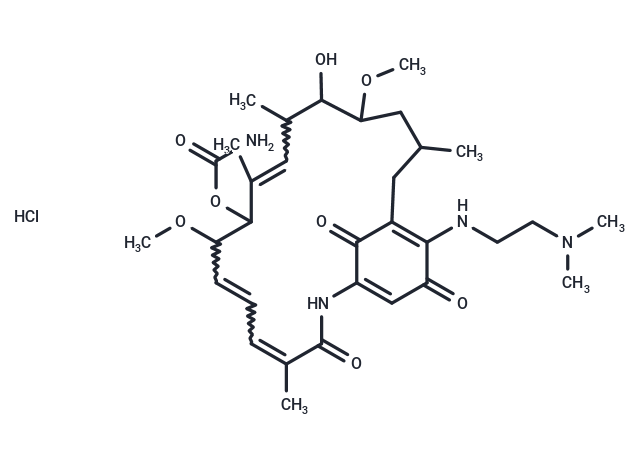Shopping Cart
- Remove All
 Your shopping cart is currently empty
Your shopping cart is currently empty

Alvespimycin hydrochloride (BMS 826476) is a potent HSP90 inhibitor with IC50 of 62 nM. Phase 2.

| Pack Size | Price | Availability | Quantity |
|---|---|---|---|
| 5 mg | $34 | In Stock | |
| 10 mg | $54 | In Stock | |
| 25 mg | $98 | In Stock | |
| 50 mg | $173 | In Stock | |
| 1 mL x 10 mM (in DMSO) | $57 | In Stock |
| Description | Alvespimycin hydrochloride (BMS 826476) is a potent HSP90 inhibitor with IC50 of 62 nM. Phase 2. |
| Targets&IC50 | HSP90:62 nM |
| In vitro | Alvespimycin displays ~2 times potency against human Hsp90 than 17-AAG, with IC50 of 62 nM versus 119 nM. In SKBR3 and SKOV3 cells which over-express Hsp90 client protein Her2, Alvespimycin causes down-regulation of Her2 with EC50 of 8 nM and 46 nM, respectively, as well as induction of Hsp70 with EC50 of 4 nM and 14 nM, respectively, leading to significant cytotoxicity with GI50 of 29 nM and 32 nM, respectively, consistent with Hsp90 inhibition. [1] Alvespimycin in combination with vorinostat synergistically induces apoptosis of the cultured MCL cells as well as primary MCL cells, more potently than either agent alone, by markedly attenuating the levels of cyclin D1 and CDK4, as well as of c-Myc, c-RAF and Akt. [3] In contrast to 17-AAG which is only active for IKKβ in chronic lymphocytic leukemia (CLL) cells, Alvespimycin treatment effectively leads to depletion of the Hsp90 client protein, resulting in diminished NF-κB p50/p65 DNA binding, decreased NF-κB target gene transcription, and caspase-dependent apoptosis. By targeting the NF-κB family, Alvespimycin selectively mediates dose- and time-dependent cytotoxicity against CLL cells, but not normal T cells or NK cells important for immune surveillance. [5] |
| In vivo | Alvespimycin treatment at 5 mg/kg or 25 mg/kg thrice per week significantly reduces tumor growth of TMK-1 xenografts, by significantly reducing vessel area and numbers of proliferating tumor cells in sections. [2] Consistent the inhibition of FAK signaling in vivo, Alvespimycin treatment at 25 mg/kg three times a week significantly suppresses tumor growth, and metastasis of ME180 and SiHa xenografts in mice. [4] Administration of Alvespimycin at 10 mg/kg for 16 days significantly decreases the white blood cell count and prolongs the survival in a TCL1-SCID transplant mouse model. [5] |
| Kinase Assay | Fluorescence polarization (FP)-based competition binding assay: This assay utilizes a boron difluoride dipyrromethene (BODIPY) labeled geldanamycin analogue (BODIPY-AG) as a probe and measured fluorescence polarization upon binding of the probe to a protein. Native human Hsp90 protein (α + β isoforms) is isolated from HeLa cells. BODIPY-AG solution is freshly prepared in FP assay buffer (20 mM HEPES-KOH, pH 7.3, 1.0 mM EDTA, 100 mM KCl, 5.0 mM MgCl2, 0.01% NP-40, 0.1 mg/mL fresh bovine γ-globulin (BGG), 1.0 mM fresh DTT, and protease inhibitor from stock solution in DMSO. Competition curves are obtained by mixing 10 μL each of a solution containing BODIPY-AG and Hsp90, and a serial dilution of 17-DMAG freshly prepared in FP assay buffer from stock solution in DMSO. Final concentrations are 10 nM BODIPY-AG, 40 or 60 nM Hsp90, varying concentration of 17-DMAG (0.10 nM-10 μM), and ≤0.25% DMSO in a 384-well microplate. After 3 hours incubation at 30 °C, fluorescence anisotropy (γEx = 485 nm, γEm = 535 nm) is measured on an EnVision 2100 multilabel plate reader. IC50 value of 17-DMAG is obtained from the competition curves. |
| Cell Research | Cells are exposed to various concentrations of 17-DMAG for 24, or 48 hours. For the assessment of cytotoxicity, MTT reagent is then added, and plates are incubated for an additional 24 hours before spectrophotometric measurement. Apoptosis is determined by staining with annexin V-fluorescein isothiocyanate and propidium iodide (PI).(Only for Reference) |
| Alias | NSC 707545, KOS-1022, BMS 826476, Alvespimycin (17-DMAG) HCl, 17-DMAG hydrochloride |
| Molecular Weight | 653.21 |
| Formula | C32H48N4O8·HCl |
| Cas No. | 467214-21-7 |
| Smiles | Cl.COC1CC(C)CC2=C(NCCN(C)C)C(=O)C=C(NC(=O)C(C)=CC=CC(OC)C(OC(N)=O)C(C)=CC(C)C1O)C2=O |
| Relative Density. | no data available |
| Storage | Powder: -20°C for 3 years | In solvent: -80°C for 1 year | Shipping with blue ice. | ||||||||||||||||||||||||||||||
| Solubility Information | Ethanol: 6.5 mg/mL (9.95 mM), Sonication is recommended. DMSO: 19.6 mg/mL (30.01 mM), Sonication is recommended. | ||||||||||||||||||||||||||||||
Solution Preparation Table | |||||||||||||||||||||||||||||||
Ethanol/DMSO
DMSO
| |||||||||||||||||||||||||||||||

Copyright © 2015-2025 TargetMol Chemicals Inc. All Rights Reserved.